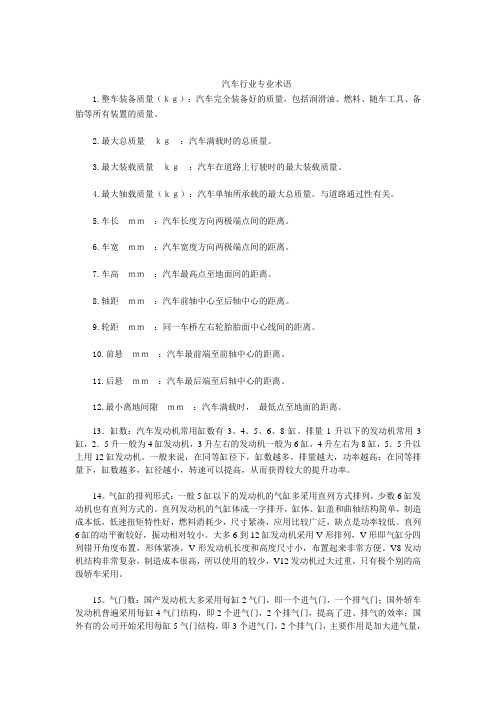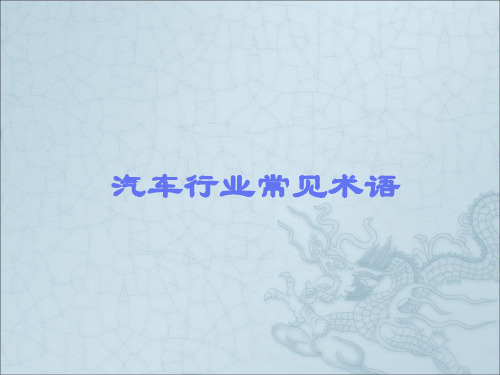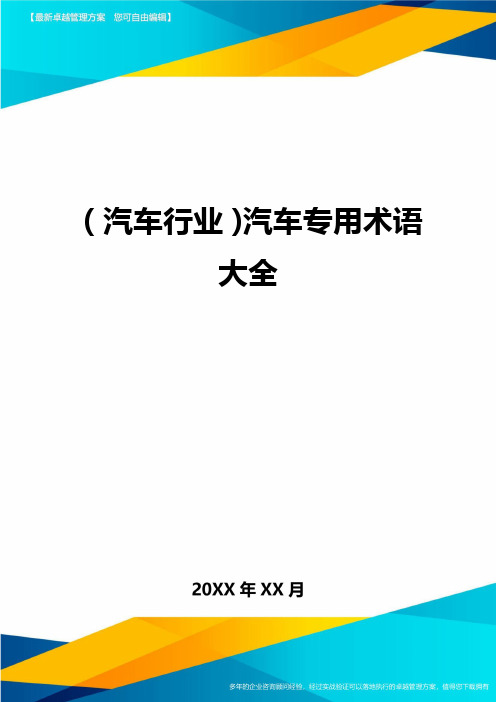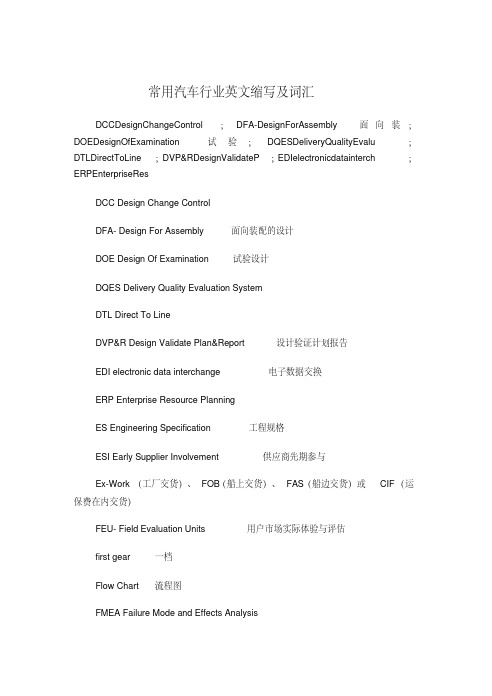汽车行业常用术语-新版.pdf
汽车行业常用英文缩写术语

OTS
:
OffToolingSample
译为“工程样件”
。
定义:在非生产节拍下,使用批量状态的工装生产的样件,用于验证产品的设计能力。
工程样件得到认可后形成的报告叫
OTS
认可报告
,也叫
工程认可报告
。主要包括:
1.
设计资料(图纸等设计资料)
;
2.PSW(
产品保证书
)
;
3.
PPAP
的目的是用来确定供应商是否已经正确理解了顾客工程设计记录和规范的所有要求,
以及其生产过程是否具有潜在能力,
在实际生产过程中按规定的生产节拍满足顾客要求的产
品。
目的:
1.
确定供方正确理解了客户所有要求;
2.
确定供方是否有能力按照适当节拍进行生产;
3.
确定质量能力是否稳定。
要求:
1.
必须是
1~8
由实验室人员上岗资格证书代替)等。
APQP
、
FMEA
、
SPC
、
MSA
、
PPAP
为质量管理五大工具,
也称品管五大工具
OTS
认可报告。
SOP
:
StartOfProduction
译为“开始量产”
,
即产品可以进行大批量生产了。
EOP
:
EndofProduction
译为“量产结束”
,是指产品生命周期结束,停止量产,此后配件一般不再批量生产和
提供,但为满足售后需要,有时还需要组织生产,但往往是按确定的订单来生产。
APQP
:
过程流程图;
6.PFMEA-
汽车行业常用术语(汽车知识、车辆知识、学习汽车、了解汽车行业常用术语)

RV的全称是Recreati&aVehicle,.即休闲车,是一种适用于娱乐、休闲、旅行的汽车,首先提出RV汽车概念的国家是日本。RV的覆盖范围比较广泛,没有严格的范畴。从广义上讲,除了轿车和跑车外的轻型乘用车,都可归属于RV。MPV及SUV也同属RV。
14.汽车导航系统
GPS是以全球24颗定位人造卫星做基础,向全球各地全天候地提供三维位置、三维速度等信息的一种无线电导航和定位系统。GPS的定位原理是:用户接收卫星发射的信号,从中获取卫星与用户之间的距离、时钟校正和大气校正等参数,通过数据处理确定用户的位置。现在,民用GPS的定位精度可达10m以内厶GPS具有的特殊功能很早就引起了汽车界人士的关注,当美国在海湾战争后宣布开放一部分GPS的系统后,汽车界立即抓住这一契机,投入资金开发汽车导航系统,对汽车进行定位和导向显示,并迅速投入使用。汽车GPS导航系统由两部分组成:一部分由安装在汽车工的GPS接收机和显示设备组成;另一部分由计算机控制中心组成,两部分通过定位卫星进行联系。计算机控制中心是由机动车管理部门授权和组建的,它负责随时观察辖区内指定监控的汽车的动态和交通情况,因此整个汽车导航系统起码有两大功能:一个是汽车踪迹监控功能,只要将已编码的GPS接收装置安装在汽车上,该汽车无论行驶到任何地方都可以通过计算机控制中心的电子地图上指示出它的所在方位;另一个是驾驶指南功能,车主可以将各个地区的交通线路电子图存储在软盘上,只要在车工接收装置中插入软盘,显示屏上就会立即显示出该车所在地区的位置及目前的交通状态,既可输入要去的目的地,预先编制出最佳行驶路线,又可接受计算机控制中心的指令,选择汽车行驶的路线和方向。
一般说,在制动力缓缓施加的情况下,ABS多不作用,只有在制动力猛然增加使车轮转速骤消的时候ABS才发生效力。ABS的另一主要功效是制动的同时打方向躲避障。因此,在制动距离较短,无法避免触障时,迅速制动转向,是避免事故的最佳选择。值得注意的是,汽车装有ABS,并不代表就一切万事大吉了。所以在此奉劝装有ABS系统的车主,万不可放心大胆地超能力驾驶,引发事故,也许ABS也救不了你。
汽车行业专业术语

汽车行业专业术语1.整车装备质量(kg):汽车完全装备好的质量,包括润滑油、燃料、随车工具、备胎等所有装置的质量。
2.最大总质量kg:汽车满载时的总质量。
3.最大装载质量kg:汽车在道路上行驶时的最大装载质量。
4.最大轴载质量(kg):汽车单轴所承载的最大总质量。
与道路通过性有关。
5.车长mm:汽车长度方向两极端点间的距离。
6.车宽mm:汽车宽度方向两极端点间的距离。
7.车高mm:汽车最高点至地面间的距离。
8.轴距mm:汽车前轴中心至后轴中心的距离。
9.轮距mm:同一车桥左右轮胎胎面中心线间的距离。
10.前悬mm:汽车最前端至前轴中心的距离。
11.后悬mm:汽车最后端至后轴中心的距离。
12.最小离地间隙mm:汽车满载时,最低点至地面的距离。
13.缸数:汽车发动机常用缸数有3、4、5、6、8缸。
排量1升以下的发动机常用3缸,2.5升一般为4缸发动机,3升左右的发动机一般为6缸,4升左右为8缸,5.5升以上用12缸发动机。
一般来说,在同等缸径下,缸数越多,排量越大,功率越高;在同等排量下,缸数越多,缸径越小,转速可以提高,从而获得较大的提升功率。
14。
气缸的排列形式:一般5缸以下的发动机的气缸多采用直列方式排列,少数6缸发动机也有直列方式的。
直列发动机的气缸体成一字排开,缸体、缸盖和曲轴结构简单,制造成本低,低速扭矩特性好,燃料消耗少,尺寸紧凑,应用比较广泛,缺点是功率较低。
直列6缸的动平衡较好,振动相对较小。
大多6到12缸发动机采用V形排列,V形即气缸分四列错开角度布置,形体紧凑,V形发动机长度和高度尺寸小,布置起来非常方便。
V8发动机结构非常复杂,制造成本很高,所以使用的较少,V12发动机过大过重,只有极个别的高级轿车采用。
15。
气门数:国产发动机大多采用每缸2气门,即一个进气门,一个排气门;国外轿车发动机普遍采用每缸4气门结构,即2个进气门,2个排气门,提高了进、排气的效率;国外有的公司开始采用每缸5气门结构,即3个进气门,2个排气门,主要作用是加大进气量,使燃烧更加彻底。
汽车制造行业专业术语大全

汽车制造行业专业术语大全1、车身结构—汽车的主体结构,包括车顶、车底、车门等部分。
2、底盘—汽车的底部结构,包括底盘框架、前后悬挂系统、驱动系统等。
3、发动机—汽车的动力源,负责产生功率以驱动车辆。
4、变速器—控制发动机输出功率并传输到车轮的装置,包括手动变速器和自动变速器。
5、制动系统—控制车辆减速和停车的系统,包括刹车片、刹车盘、刹车液等部分。
6、悬挂系统—支撑和平衡车身的系统,包括弹簧、避震器、悬挂臂等。
7、燃油系统—用于储存和供应燃料给发动机的系统,包括油箱、燃油泵、喷油嘴等。
8、排气系统—将废气从发动机排放出去的系统,包括排气管、催化器、消声器等。
9、电子控制单元(ECU)—控制和监测车辆电子系统的计算机模块。
10、车身电子系统—控制车辆的电子设备,包括仪表盘、音响系统、导航系统等。
11、碰撞安全系统—预防和减轻碰撞伤害的系统,包括安全气囊、车身结构设计等。
12、高强度钢—在车身结构中使用的高强度钢材,用于提高车体刚性和安全性能。
13、轮胎—安装在轮毂上,与地面接触的橡胶制品,提供车辆的抓地力和悬挂舒适性。
14、助力转向系统—增加转向力和减轻驾驶员转向努力的系统,通常采用液压或电动助力。
15、故障诊断系统—监测和诊断车辆故障的系统,通过传感器和计算机分析车辆性能。
16、排放控制系统—控制和减少车辆排放物的系统,包括催化器、氧传感器、排气循环阀等。
17、充电系统—向电动车辆或混合动力车辆供应电能的系统,包括电池、充电器等。
18、能量回收制动系统—利用制动过程中的能量转化为电能,储存起来用于供应给电动设备。
19、车辆动力学—研究车辆运动和行驶性能的学科,包括加速度、制动距离、操控稳定性等。
20、燃油经济性—衡量车辆燃油利用效率的指标,通常以每加仑或每百公里行驶的里程为单位。
(完整版)汽车行业英文术语文档

1.行业相关词汇(部分):2.公司概况company profile3.主要/主营业务main business4.业务范围business scope5.核心价值core value6.核心竞争力core competence/competitiveness7.核心应用系统core application system8.成功案例success story/case9.典型案例typical case10.案例研究/分析case study11.汽车配件/备件/零件automotive (spare)parts12.汽车附件automotive accessories13.部件/元件/组件components14.汽车后市场aftermarket15.配件市场parts market16.经销商管理系统Dealer Management System(DMS)17.经销商协同管理系统Dealer Collaboration Management System (INFODCS)18.整车销售管理系统Vehicle Sales Management System (INFOVSM)19.配件运作管理系统Spare/Service Parts Management System (INFOSPM)20.索赔管理系统Warranty Management System (INFOWS)21.技术资料发布系统Technical –data Viewer ((INFOTDV)22.英孚商用数据交换平台(INFOX) B2B Data Exchange Platform23.经销商订单管理系统dealer order management system24.售后配件管理系统Spare/Service Parts management system(SPM)25.集成管理系统integrated management system26.数据分析系统data analysis system27.销售配额sales quota28.配额管理quota management29.配额式订单管理系统quota-based order management system30.配额式订单管理模式quota-based order management mode31.主数据管理master data management(MDM)32.操作系统operating system (OS)33.应用系统application system34.实施服务implementation service35.一站式服务one-stop shop/one-stop services36.综合性的一揽子服务(方案) a comprehensive package of services37.现场服务on-site service38.现场培训on-site training39.现场实施on-site implementation40.现场分析on-site analysis41.现场管理field/on-site management42.车厂/主机厂/整车制造商/车辆制造厂OEM/automaker43.整车物流(finished) vehicle logistics (FVL)/outbound logistics(注:整车以后可以一致翻为vehicle,如前加finished也可以)44.先进的整车物流advanced (finished) vehicle logistics(AFVL)45.整车配送vehicle delivery46.整车/车辆匹配vehicle matching47.4S-整车销售(Sale),零配件(Spare part),售后服务(Service),信息反馈等(Survey)48.线上车辆状态跟踪online vehicle status tracking49.线上预配车模块online vehicle pre-allocation module50.车辆滞留时间vehicle holdup period51.配车冻结vehicle allocation freezing52.生产冻结期production freezing time53.提前分销/分配pre-distribution54.生产周排产计划weekly production schedule55.管线内车辆vehicles in the pipeline56.(车辆)下线时间offline time/ off-production-line time57.(车辆)上线时间online time58.系统上线system go-live59.资源配置/分配resources allocation/distribution60.产品推广products deployment(注:本行业产品推广一般是系统推广部署之意,区别与一般产品的推广促销products promotion)61.业务流程business process62.持续支持on-going/continuous support63.长期支持long-term support64.订单查询order inquiry/query(注:前者一般电话查询等,后者一般网上查询)65.签收•sign-in66.软件外包software outsourcing67.服务站service station68.服务中心service centre69.功能模块function/functional module70.召回recall71.无缝连接seamless connection/joint72.J2EE架构J2EE architecture73.J2EE 框架J2EE framework74.展厅管理showroom management75.备件库存spare parts inventory/stock76.物料出入库material issuing and receiving77.出库/仓库交货goods issuing/delivery/ex-warehouse78.叉车厂forklift truck works79.库存深度stock depth80.库存积压/压库overstock81.汽车配件厂auto parts plant82.汽车维修厂automotive service shop83.汽车修理厂automotive repair shop84.汽车维修工程有限公司Auto maintenance engineering Co. Ltd85.汽车养护有限公司car maintenance Co. Ltd86.汽车美容护理中心Auto care centre87.大客户销售经理Fleet Sales/Key Account Manager88.订单处理order processing/handling89.延期交货订单/欠货订单back order90.实时客户订单real-time customer order91.客户名单customer list92.客户跟进customer follow-up93.潜在客户potential customer/prospect94.客户服务满意(度)customer service satisfaction95.客户满意度(指标)customer satisfaction index (CSI)96.客户关怀customer care97.客户忠诚度customer loyalty98.授权及审批authorization and approval99.保修/索赔申请warranty claim100.回运件/返修件/旧件return parts101.最佳实践best practice102.同步传输synchronous transmission103.异步传输asynchronous transmission104.消息组播message multicast105.安全密码认证Security Password Authentication106.日志管理log management107.多重组网domain based routing rules \108.批量数据上传batch data upload109.电子数据交换electronic data interchange (EDI)110.数据库连接池database pool111..数据源data source\112.线形图linear chart113.柱形/条形图/直方图bar chart/histogram114.饼图pie chart115.托管/寄存服务hosting service116.绩效考核指标体系设计performance index design117.绩效评价体系设计performance evaluation system design 118.绩效管理体系performance management system119.关键业绩指标key performance index (KPI)120.应用编程接口application programming interface (API)121.系统部署system deployment122.试运行pilot/ trial/test running(注:本行业常用pilot)123.集中培训centralized training124.系统切换system cutover125.无线接入wireless access126.办公自动化office automation (OA)127.虚拟专用网virtual private network(VPN)128.故障管理fault management(FM)129.故障模式与结果分析Fault Modes and Effect Analysis (FMEA) 130.故障率Failure Rate131.故障记录Failure Record132.三包服务three-guarantee service/sanbao service133.集中构架技术integrated architecture technology134.分布式构架技术distributed architecture technology135.集中式服务组合centralized architecture136.分布式服务组合decentralized architecture137.国际商用机器公司International Business Machines Corporation (IBM) 138.硬件及安全网络中心system support and network security centre 139.物流规划logistics planning140.数据转换data conversion141.数据移植/迁移data migration142.双边/双方承诺bilateral /mutual commitment143.项目启动会project kickoff meeting144.售后服务after-sale service(ASS)/after service/service145.质控quality control (QC)146.质量保证quality assurance (QA)147.价格管理pricing management148.终端市场end-market149.横向协作horizontal collaboration150.纵向支持vertical support151.综合实力comprehensive strength152.良性循环benign/virtuous cycle/circulation153.前后台运作front and back-end operation154.大/关键客户销售经理: Fleet Sales/Key Account Manager155.产品责任product liability156.订单完成率order fulfillment/completion rate157.汇报会report/review meeting158.双周总结/汇报会bi-weekly review meeting159.根源分析root cause analysis160.滚动需求rolling demand161.产供销链production, supply & sales chain162.供应链战略supply chain strategy163.供应链管理supply chain management164.连锁店管理chain store management165.经销商销售预测dealer sales forecast166.销售支持与费用结算sales support & expense settlement167.订单交付Order to Delivery (OTD)168.刚性生产计划rigid production plan169.订单管理流程order management process170.营销总部sales & marketing headquarter171.量化管理quantitative management172.项目管理办公室project management office (PMO)173.灾难恢复计划disaster recovery plan(DRP)174.电子配件目录electronic parts catalogue(EPC)175.企业资源计/规划enterprise resource Planning (ERP)176.客户关系管理customer relationship management (CRM)177.业务流程重组/再造Business Process Reengineering(BPR)178.战略业务单元/战略性事业单位/策略性事业单位strategic business unit (SBU)。
汽车行业常见术语汇总

MSA:Measurement System Analysis 测量系统分析
测量系统:借用某种工具(量具、检具、设备、软件等)通过某种方法对 特定半成品或成品赋值的全过程。
测量系统分析:使用数理统计和图表的方法对测量系统进行分析,以评估 测量系统的分辨率和误差对于被测量的参数来说是否合适,并确定测量系 统误差的主要成分。
CP:Control Plan 控制计划
定义:控制计划是对控制产品所要求的系统和过程的文件化的描述。 通俗来讲就是对一个产品从进料到发货的全过程的特性进行定性定量的 规定,以确保成品或服务的质量稳定。 分类:样件控制计划、试生产控制计划、生产控制计划
示例
BOM:Bill of Material 物料清单
Repeatability重复性
G R&R
误差
Producibility再现性
偏倚
1.Bias偏倚;2.Linearity线性;3.Stability稳定性
常见输出:计量型、计数型2种报告 常用软件:MiniTab
测量系统类型 基本计量型
MSA方法 级差,均值和极差,方差分析(ANOVA),偏倚,线性,控制图
PPAP文件包含:
1.PSW;2.BOM;3.检测报告(4种类型);4.产品特殊特性清单;5.Process flow diagram过程 流程图;6.PFMEA-过程潜在失效模式及后果分析;7.工艺设备调查表;8.工装模具一览表;9. 检验设备一览表;10.MSA测量系统分析;11.Cpk & Ppk-初始过程能力研究;12.Control plan生 产控制计划;13.包装认可报告;14.其他客户特殊要求的,IMDS、包装指导书,产能分析表、 具有资格的实验室文件(可以由实验室人员上岗资格证书代替)等。
【汽车行业类】汽车专用术语大全

(汽车行业)汽车专用术语大全汽车专用术语大全1、引擎系统(AutomotiveEngineSystem)燃烧室(CombustionChamber)活塞到达上死点后其顶部和汽缸盖之间的空间,燃料即在此室燃烧。
压缩比(CompressionRatio)活塞在下死点的汽缸之总容积除以活塞在上死点的总容积(燃烧室容积),所得的值就称为压缩比。
连杆(ConnectingRod)引擎中连接曲轴和活塞的连接杆。
冷却系统(CoolingSystem)可藉冷却剂的循环,将多余的热量移出引擎,以防止过热的系统。
在水冷式的引擎中,包括水套、水泵、水箱及节温器。
曲轴箱(Crankcase)引擎下部,为曲轴运转的地方,包括汽缸体的下部和油底壳。
曲轴(Crankshaft)引擎的主要旋转机件,装上连杆后,可承接连杆的上下(往复)运动变成循环(旋转)运动。
曲轴齿轮(CrankshaftGear)装在曲轴前端的齿轮或键齿轮,通常用来代动凸轮轴齿轮,链条或齿状皮带。
汽缸体(CylinderBlock)引擎的基本结构,引擎所有的零附件都装在该机件上,包括引擎汽缸及曲轴箱的上半部。
汽缸盖(CylinderHead)引擎的盖子及封闭汽缺的机件,包括水套和汽门及冷却片。
爆震(Detonation)为火焰的撞击或爆声,在火花点火引擎的燃烧室内,因为压过的空气燃料混合气会自燃,于是使部份未燃的混合气产生二次点火(在火星塞点火之后),因而发出了爆声。
排气量(Displacemint)在引擎的某壹循环运作中,能将全部空气及混合气送入所有汽缸的能力,也是指壹个活塞从壹个行程运作至另壹行程所能排的体积。
引擎(Engine)壹种能将热能转变为机械能的机械:壹种可将燃料燃烧产生机械动力的装置;有时可视为壹种发动机。
风扇皮带(FanBelt)壹种由曲轴带动的皮带,其主要目的是带动引擎风扇和水泵。
浮筒油面高度(FloatLevel)化油器浮筒室内,浮筒浮起而顶住针阀,堵住进油口,使油不再流入浮筒室时,油面的高度。
新版汽车行业术语缩写.pdf

常用汽车行业英文缩写及词汇DCCDesignChangeControl;DFA-DesignForAssembly面向装;DOEDesignOfExamination试验;DQESDeliveryQualityEvalu;DTLDirectToLine;DVP&RDesignValidateP;EDIelectronicdatainterch;ERPEnterpriseResDCC Design Change ControlDFA- Design For Assembly 面向装配的设计DOE Design Of Examination试验设计DQES Delivery Quality Evaluation SystemDTL Direct To LineDVP&R Design Validate Plan&Report设计验证计划报告EDI electronic data interchange 电子数据交换ERP Enterprise Resource PlanningES Engineering Specification工程规格ESI Early Supplier Involvement 供应商先期参与Ex-Work(工厂交货)、FOB(船上交货)、FAS(船边交货)或CIF(运保费在内交货)FEU- Field Evaluation Units 用户市场实际体验与评估first gear 一档Flow Chart 流程图FMEA Failure Mode and Effects Analysisfour-wheel drive 四轮驱动FRG- Ford Reliability Guideline 福特可靠性指导Front Windshield 前挡风玻璃Tempered glass 钢化玻璃front-wheel drive 前轮驱动FSS- Full service supplier 全服务供应商FTA Fault Tree AnalysisGD&T- Geometric Dimensioning & Tolerancing 标准公差GR&R G uage Repeatability&reproducibility量具的重复性和再现性HTFB- Hard Tooling Functional Build 工装集成调试与验证IPO Individual Parts OrderISIR Initial Sample Inspection ReportJIT Just In TimeKD- knocked down/ Semi Knock Down(SKD) /Completely Knock Down(CKD)KO Kick-offLaminated glass 夹层玻璃LP-Lean Production 精益生产LR Launch ReadinessLS Launch SupportLVPM Local Vendor Packaging MethodMPV Multi-PurposeVehicle 多用途汽车MRD Material Required DateMRO Maintenance,Repair,and OperationMTP- Make to print supplier 照图加工供应商N/A- Not ApplicableNCDR Non-Conforming Delivery ReportNCMAR Non-Conforming Material Action ReportNDA Non Disclosure Agreement 保密协定NDS Nissan Design SpecificationNML Nissan Motor LtdNVH- System Noise, Vibration & Harshness 系统噪音,振动及粗糙性OSM- Outside of MaterialPA Program Approvalpallet n. 托盘Passenger Vehicle 乘用车PAT- Program Attributes Team 产品属性小组PDL Product Design LetterPH Proportions&HardpointsPIPC- Percentage of Indexes with Process Capability 能力指数百分比PIST- Percentage of Inspection points Satisfying Tolerance 检测点满意工差百分比PMT- Program Moudle Team 产品模块小组PO Purchase OrderPPAP- Production Part Approval Process 生产件批准程序PPSR Production Preparation Status ReportPQA Process Quality AssurancePR Program ReadinessPre-Launch 试生产price-driven costing 价格引导成本Production Preparation-Final Nissan - PT2/Renault - PPProduction Preparation-Initial Nissan - PT1/Renault - PPP3Production Trial Run 试生产Prototype 样件QFD Quality Funtion Deploy质量功能展开QFTT Quality Functional Task TeamQR- Quality Reject 质量拒收QS Quality StandardRAN Release Authorisation Numberreverse 倒车档RFQ Request For Quotation询价RKD Reverse Knock DownRLQ Receiving Lot QuantityROC Rate of ClimbROI return on investment 报酬率ROP Re-Order PointRTO Required To OperateSAIS Supplier Assessment & Improvement SystemSC Strategic Confirmation/significant Charac''teristicsSDS- System/ Design Specifications 系统/设计说明second gear 二档SFMEA System FMEAShipping Date 出货日、Invoice Date 发票日或On Board Date 装船日Side Windshield 侧窗玻璃SJ Strategic IntentSNP Standard Number of PartsSOW- state of work 工作申明SPC Statistical Process ControlSQA Supplier Quality AssuranceSREA- Supplier Request for Engineering Approval 供应商工程设计更改申请ST Surface TranferSTRS Supplier Test Report System Subcontractor 分承包商Sunroof Windshield 天窗玻璃SUV Sports Utility VehicleTAG Test Aptitude GraphiqueTCO Total Cost of Ownership 总持有成本TCRA Total Cost Reduction ActivityTGR Things Gone RightTGW Things Gone WorstTM Techinical ManualTPM Total Preventive MaintenanceTTO-Tool Try Out 工装验证UOM Unit Of MeasureVES Vehicle Evaluation SystemVO- Vehicle Operation 主机厂VPP- Vehicle Program Plan 整车项目计划VQA Vehicle Quality AssuranceVTTO- Vendor Tool Try-Out 供应商工装验证WERS- World Wide Engineering Release SystemWVTA Whole Vehicle Type ApprovalOTS OFF TOOL SAMPLE 用批量生产的工模器具制造出的样件PVS Produktions Versuchs Serie 批量试生产TMA Trial Manufacturing Agreement2TP 两日试生产,主要是验证供应商的批量供货能力OS 零批量,是批量生产前的总演习,批产的全面验证SOP Standard Operation 即批量生产Start-Of-Production Standard Operating Procedure 标准操作程序QSV Qualitaes-Sicherungs-Vereinbarung 质量保证协议BMG Bau-Muster-Genehmigung 产品工程样件性能检验认可Nullserie 零批量QSR 质量体系要求Bias 偏差DB Durability Build 样车阶段lead time n.订货至交货的时间sink mark 缩痕LRR launch readiness reviewYC (Potential Critical Characteristic) 潜在关键特性YS (Potential Significant Characteristic) 潜在重要特性Restriction of Hazardous Substances 简称RoHS SGS, BV, TUV, Intertek, ETC BV-Bureau Veritas 法国国际检验局Front bumper 前保险杠Rear bumper 后保险杠Radiator grille 格栅Headlamp 前大灯Tail lamp-liftgate 尾灯-行李箱盖上Tail lamp-quarter 尾灯-后侧围上Front door trim panel 前门内饰板Rear door trim panel 后门内饰板Interior release handle bezel 内开手把手框Power controls bezel 电动车窗开关框Window interior capping 窗框饰条Exterior mirror 外后视镜Body side moulding 防擦条Cowl grille 通风格栅Roof molding 车顶装饰条Lift gate molding 牌照板支架Lift gate handle 行李箱盖拉手Weather strip_door openings 门框胶条 Weather strip_liftgate 行李箱胶条A Pillar Trim A柱B Pillar Trim upper B柱上B Pillar Trim lower B柱下Front scuff Plate 前门槛条Rear scuff plate 后门槛条Back panel trim lower 行李箱门槛条 Garnish trim-Quarter window Cowl trim panel A柱下Liftgate upper trim 尾门内饰板上 Liftgate side trim 尾门内饰板中 Liftgate lower trim 尾门内饰板下 IPDefroster panel 除霜盖板Console 中控台Steering column cover 方向机柱上下盖板 Cluster 组合仪表Carpet 前地毯Trunk carpet 后地毯Front seat 前座椅2nd row seat 第二排座椅burr(金属) flash(塑件)毛边gap 间隙defective products 不良品finished products 成品disposed products 处理品沿用件COP更改类型Modification原FS号Ori. FS No.图纸日期Spec. Date目标重量Weight Target样件Prototype 备注Comment具体进度Milestones工装样品OTS Sample(BMG) 工装样件Prototype(BS1) 首批样品FBD (PVS) ,EM Temin (no BMG)零批量生产Zero-Production Run (0S)起步生产SOP(开始批量生产)。
- 1、下载文档前请自行甄别文档内容的完整性,平台不提供额外的编辑、内容补充、找答案等附加服务。
- 2、"仅部分预览"的文档,不可在线预览部分如存在完整性等问题,可反馈申请退款(可完整预览的文档不适用该条件!)。
- 3、如文档侵犯您的权益,请联系客服反馈,我们会尽快为您处理(人工客服工作时间:9:00-18:30)。
(CP) <FS> (J1) (PT) PT ( P/T ) (ST) <CC> <LR> <LS> <PA> <PH> <PR> <PS1> <PS2> <SC> <SI> <SP> (SP) (TTO)
Global 8D
14D
1MIS 1PP 2PP 3MIS 4P AAA ABS ABS AIAG AIC AIM AIMS AME AMPPE ANLeabharlann VA AP— Sep 2003
Page 1 of 11
录
中文译名
确认样车 最终状态 整车投产 动力传动系统设计结束 动力传动系统 表面参数传递 更改完成 投产准备就绪 投产验收 项目批准 比例与固定点 产品准备就绪 SI 前里程碑 1 SI 前里程碑 2 策略确认 策略意向 策略计划 样车结构 工装设备试运行 G8D (福特公司解决问题的标准方法 ) 更详细的细节 (包括并解决停止运 货 /召回问题 ) 投入使用 1 个月 第一次试生产 第二次试生产 投入使用 3 个月 生产程序验证项目 美国汽车工业联合会 可承受商业结构 防抱死制动系统 机动车工业行动小组 快速实施中心 问题结构图 问题结构图系统 先进制造工艺 先进项目前制造工艺 多样性分析 设计样车
Pilot
Acronym List
缩
写
目
TERM
Confirmation Prototype Final Status Job 1 P/T Design Complete Power Train Surface Transfer Change Cut-Off Launch Readiness Launch Sign-Off Program Approval Proportions & Hardpoints Product Readiness Pre<SI> Milestone 1 Pre<SI> Milestone 2 Strategic Confirmation Strategic Intent Strategic Planning Structural Prototype Tool Try-Out
CRONYM
APEAL APQP ASQ AV AVT AWS AXOD
B&A
BCG BIC BIS BLI BOM BTB BTS BUR CAS C/E CA CAD CAE CAP CBG CC CC CC CCC CDS CET CETs CETP CFR CIM CIWG CL CMM CMMS CMMS3
Pilot
Acronym List
缩
写
目
TERM
Automotive Performance Execution and Layout Advanced Product Quality Planning American Society for Quality Appraiser Variation Advance Vehicle Technology Analytical Warranty System Automatic Transaxle Overdrive Transmission Body & Assembly Operations (New Term: Vehicle Operations) Business Consumer Group Best in Class Body Shop Information System Business Leadership Initiative Bill Of Materials Bumper-to-Bumper Build-To-Schedule Business Unit Review Capacity Analysis Sheet Cause & Effect Customer Attribute Computer Aided Design Computer Aided Engineering Corrective Action Plan Consumer Business Group Critical Characteristic Courtesy Copy Carbon Copy Customer Concern Classification Component Design Specification Campaignable Events Team Common External Tariff Corporate Engineering Test Procedures Constant Failure Rate Computer Integrated Manufacturing Continuous Improvement Work Group Centerline Coordinate Measuring Machine Common Material Management System Common Manufacturing Management System-3
Eight disciplinary Actions
More Detailed than Global 8D (used to contain and resolve stop-shipment/recall problems) One Month in Service First Production Proveout Second Production Proveout Three Months in Service Production Process Proveout Program American Automobile Association Affordable Business Structure Anti skid brake system Automotive Industry Action Group Accelerated Implementation Centre Automated Issues Matrix Automated Issues Matrix System Advanced Manufacturing Engineering Advanced Manufacturing Pre-Program Engineering Analysis of Variance Attribute Prototype
